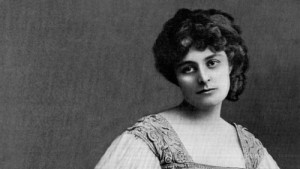“Last night all my household had retired at a quarter to 11 and I thought I would go to you astrally[…] We went somewhere in space I don’t know where – I was conscious of starlight & of hearing the sea below us[…] We melted into one another till we formed only one being.”
–The Gonne-Yeats Letters, via poets.org
After reading this excerpt written in July of 1908 by Maud Gonne to W.B. Y., it seems natural for one to grow intrigued by the “occult-esque” romance between this literary duo. After today’s lecture, I was curious about Maud as a woman in Ireland, who at the time felt like a pioneering feminist—le maître of The Daughters of Ireland, the radical leader of a movement. After close consideration of Yeats’ essay on “The Symbolism of Poetry,” it appeared eerily coincidental that both Maud and Yeats were enamored by “things unseen”—a realm slightly outside of physical experience, a seemingly alluring escape within the mind that permitted one to be overcome by the whimsy of the Druids… yet, it was a world which ultimately lacked concrete progress and measurable advancement. This idea is not only emphasized in Maud’s 1908 letter where she states, “[…] material union is but a pale shadow” compared to the spiritual union she experiences in her dream-state, but also in “The Symbolism of Poetry.” Yeats says, “the laws of art […] can alone bind the imagination.” With this, the reader is left to understand that Yeats’ image of “true” poetry is rooted in the realm of imagination—of semiotics and signifiers working together to convey emotion.
In the eyes of a feminist critic, it appears that Yeats’ logic of worshiping symbolic meaning fails when it is ignorantly applied to women, specifically Maud. The idea that Yeats’ wanted to turn women into symbols is evident in Cathleen Ni Houlihan, where Maud appears as the old woman (symbolic of Ireland). The irony of the role seems to supplant Maud’s idealism: she willingly subjects herself to being deduced to an artifice while simultaneously proclaiming herself to be a radical crusader for feminine power and Irish freedom.
It’s interesting to note Maud’s interest in championing Irish goddesses from Celtic myths as Idols: Maud willingly puts intellectual investment in a semiotic domain. The empowerment of women, when viewed as being extracted from the Goddesses of lore, falls flat and even base-less. While Maud was an optimistic activist for her cause, her efforts seem to have operated on a faulty axis, where women extracted their strength from “castles in the air”– tales of mythical women like Queen Maeve, Niamh, etc.—without the notion that their strength could push beyond the mythological realm and into something more tangible. While it’s nice to find inspiration from the artistic, traditional sphere of Ireland’s mythology, it appears dangerous and all too radical for the faith of liberation to be propped solely on an elusive and almost untouchable platform.

